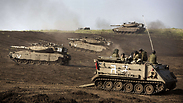
(archives)
צילום: AFP
The IDF of the next war
Analysis: Army chief Gantz's bold and revolutionary plan far more significant than money it is saving
Before the cabinet ministers approve the IDF's new multi-year plan, they must understand that they are not signing off on another cutback plan in the army. Although we are not talking about yet another idea involving a "small and smart army" – a term military people like to use – this is not another ploy meant to frighten the public. Behind the numbers, graphs and billions of shekels, IDF chief Gantz is presenting an army that will have a completely different operational outlook – and this is a bold and revolutionary measure that is far more significant than just the money that is being saved.
The chief of staff has been working on the plan for two years, meaning the new operational outlook is not the result of the new budgetary constraints. In its essence, the plan is similar to the military doctrine the Americans implemented during the Second Gulf War under the title "shock and awe," with the necessary adjustments to our arena: The use of massive force at the onset of the campaign with the goal of destroying targets from the air, sea and ground using accurate ammunition, followed by a quick and powerful ground maneuver in order to bring an end to the conflict in a short period of time.
Gantz gave an order: The time factor is critical, and the campaign must be shortened because the home front is paying a heavy price. The new operational outlook presents a swift transition to a state of war and the implementation of the "shock and awe" doctrine to achieve the campaign's goal within a few days.
In order to realize this operational vision the IDF must train units for specific purposes. On the basis of the ground forces, which will be scaled back, the IDF will establish three types of divisions: Divisions that will deal with defense in the various sectors, divisions that will be a part of the reserves and "light" divisions capable of entering enemy territory in a number of sectors simultaneously. In addition, emphasis will be placed on developing the capabilities of the special forces.
The IDF had no choice. Even without the budgetary problem, the army would have to change its operational outlook and its structure to adapt itself to the new threats in the arena. According to estimates, the IDF has a window of at least two years – due to the crisis in the Arab world – to begin implementing these changes without taking too great a risk or in a way that would make it appear as though it is not ready for battle. If Gantz wouldn't have done it, the next chief of staff would have had to.
In the framework of this new operational outlook the land army is becoming smaller and is giving up the soon-to-be obsolete armored forces that will not survive tomorrow's battlefield. The compensation for the reduction in the number of tanks must come in the form of better quality tanks and technologies that will be at the land army's disposal. In case the army fails to produce enough new tanks, the land army will be just a small army, not even a smart one. The IDF can afford to give up on some of its ground and aerial platforms because its advanced intelligence and communications capabilities provide much more precise data on many more targets to many more weapons. So, with the use of accurate fire, the army can destroy on a scale we have not seen in the past: Four fighter jets can do today what an entire squadron was incapable of doing 30 years ago.
The army claims that due to the cutbacks it is in need of advanced weaponry and systems that will allow it to implement the new operational outlook, meaning an addition of at least NIS 10 billion ($2.77B) in the next five years. Gantz's plan is somewhat of a gamble, because despite the current cuts he is counting on the government to eventually add a certain amount to his budget.
But Gantz is doing more than this: His plan hinges on the hope that this government will remain in power for at least the next four years and that the budgetary crisis will end in 2015. If even one of these conditions does not hold up, the army will be left with a partial reform – and this is the worst thing that can happen to the army and to us.










